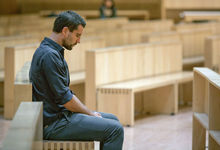Interpreting signs — a vote of non-confidence
So the signs of the time are frightening. Which means that the return of Christ must be near, right? The Chief Apostle responds to this notion in a recent article: such attempts at interpretation are doomed to fail. Following is a summary. .

Does contemporary history provide us with clear indications concerning the current status of salvation history? Does it make sense to see the signs of the time as evidence that the return of Christ is near? This is the key topic in the latest publications of “community” and “Our Family”. They are based on an article originally published in Special Edition 2/2018 of the minister magazine known as the Divine Service Guide.
The key to understanding
In both the Old and New Testaments, it is absolutely clear that God reveals Himself by way of His actions in history. The central events of salvation in each are the liberation of Israel from Egypt and the incarnation of God in Jesus Christ, respectively.
It is true that formulations such as “when the fullness of the time had come” connect salvation history with world history. However, the manner in which specific conditions are met is never mentioned. The key to understanding cannot be found in objective evidence, but in faith alone.
This also applies to the renewed occupation of the Apostle ministry. While this event is indeed an indication that salvation history has entered into a new phase—which will at some point conclude with the return of Christ—it can only be perceived as such by someone who believes that the Apostle ministry has been occupied anew by divine agency.
In search of evidence
What are the signs that herald the return of Christ? These questions were already raised by the disciples themselves—and Jesus responded to them with His so-called discourses on the end time (Matthew 24/25, Mark 13, and Luke 21). Wars, catastrophes, false teachers, and Christian persecutions—but also the universal preaching of the gospel—are listed here as indicators of the end.
“A more detailed inspection of the text will show that it is impossible to link these statements to concrete historical events,” clarifies Chief Apostle Jean-Luc Schneider:
- Not only in our day, but throughout the ages, people have considered the events of their time to be so monstrous and unique that they must be regarded as clear indicators of the return of Christ.
- Often the focus was only on Europe, and people tended to forget all about historical catastrophes on other continents.
- In the here and now, none of us can say with certainty that our experiences are any worse or less tolerable than that which our ancestors, or nations on other continents, had to experience—or must still experience.
The Church leader summarises these remarks by stating that “the totality of all historical events is an indication that the return of Christ is necessary.”
Holding fast to faith
The Chief Apostle criticises such efforts to interpret specific historical events as evidence: “It seems people think that belief in the return of Christ would require some sort of affirmation or confirmation.” But that “would be tantamount to a vote of non-confidence in God’s faithfulness to His promise!”
After all, the demand for signs is contradictory to the testimony of the New Testament. For example, Jesus clearly refuses to show His authority to the scribes and Pharisees (Matthew 12: 39). And Paul makes a point of attaching greater importance to faith than to proof by miracles or reasoning (1 Corinthians 1: 22–23).
“We cannot infer that this event is any more or less imminent from the horrible things that are taking place in this world,” emphasises Chief Apostle Schneider. “What is required here is our faith in the biblical testimony and the apostolate. Let us hold on to this faith, whose sole foundation is the promise of Jesus Christ.”
Photo: wernerimages - stock.adobe.com














